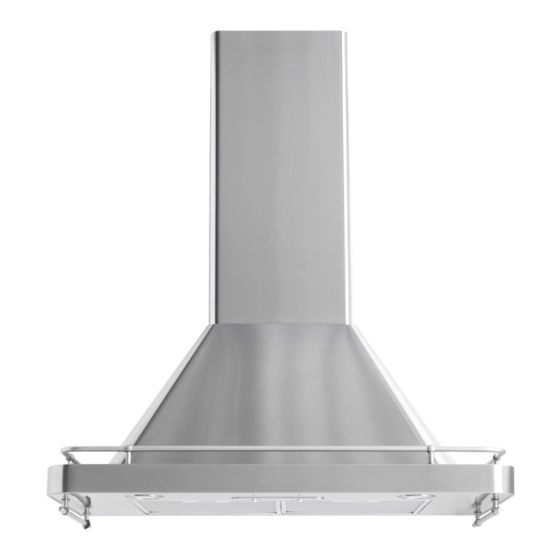IKEA DATID Instruções de instalação e manual de utilização e cuidados - Página 6
Procurar online ou descarregar pdf Instruções de instalação e manual de utilização e cuidados para Hob IKEA DATID. IKEA DATID 18 páginas. 30" (76.2 cm) wall-mount canopy range hood
Também para IKEA DATID: Manual do utilizador (16 páginas), Manual de instalação (12 páginas), Manual (24 páginas)

- 1. Range Hood
- 2. Range Hood Safety
- 3. Important Safety Instructions
- 4. Read and Save These Instructions
- 5. Tools and Parts
- 6. Venting Requirements
- 7. Electrical Requirements
- 8. Installation Instructions
- 9. Install Range Hood
- 10. Make Electrical Connection
- 11. Complete Installation
- 12. Range Hood Care
- 13. Wiring Diagram
- 14. Assistance or Service
- 15. Instructions D'installation
Cabinet Dimensions
7¹⁄₄" (18.4 cm)
6⁵⁄₈" (16.8 cm)
7³⁄₈" (18.7 cm)
Side
cabinet
30" (76.2 cm)
"X"
bottom of
canopy
to cooking
surface
*For non-vented (recirculating) installations
IMPORTANT:
Minimum distance "X": 24" (61.0 cm) from electric cooking
surface.
Minimum distance "X": 27" (68.6 cm) from gas cooking
surfaces.
Suggested maximum distance "X": 36" (91.4 cm)
The chimneys can be adjusted for different ceiling heights. See
the following chart.
Vented Installations
Min. ceiling height
Electric cooking
7' 7" (2.31 m)
surface
Gas cooking
7' 11" (2.41 m)
surface
Non-vented (recirculating) Installations
Min. ceiling height
Electric cooking
7' 8" (2.34 m)
surface
Gas cooking
7' 11" (2.41 m)
surface
*NOTE: The range hood chimneys are adjustable and designed
to meet varying ceiling or soffit heights depending on the
distance "X" between the bottom of the range hood and the
cooking surface.
6
2" (5.1 cm) min.
6" (15.2 cm) min.*
Vent and power
supply cable
entry location
15" (38.1 cm)
Side
cabinet
Centerline
Cooking surface
Max. ceiling height
9' 5" (2.87 m)
9' 5" (2.87 m)
Max. ceiling height
9' 8" (2.95 m)
9' 8" (2.95 m)
Venting Requirements
(vented models only)
■ V ent system must terminate to the outdoors except for
non-vented (recirculating) installations.
■ D o not terminate the vent system in an attic or other
enclosed area.
■ D o not use 4" (10.2 cm) laundry-type wall cap.
■ U se metal vent only. Rigid metal vent is recommended.
Plastic or metal foil vent is not recommended.
■ T he length of vent system and number of elbows should be
kept to a minimum to provide efficient performance.
For the most efficient and quiet operation:
■ U se no more than three 90° elbows.
■ M ake sure there is a minimum of 24" (61 cm) of straight
vent between the elbows if more than 1 elbow is used.
■ D o not install 2 elbows together.
■ U se clamps to seal all joints in the vent system.
■ T he vent system must have a damper. If the roof or wall
cap has a damper, do not use the damper supplied with the
range hood.
■ U se caulking to seal exterior wall or roof opening around
the cap.
■ T he size of the vent should be uniform.
Cold Weather Installations
An additional back draft damper should be installed to minimize
backward cold air flow and a thermal break should be installed
to minimize conduction of outside temperatures as part of the
vent system. The damper should be on the cold air side of the
thermal break.
The break should be as close as possible to where the vent
system enters the heated portion of the house.
Makeup Air
Local building codes may require the use of makeup air
systems when using ventilation systems greater than specified
CFM of air movement. The specified CFM varies from
locale to locale. Consult your HVAC professional for specific
requirements in your area.
Venting Methods
This canopy hood is factory set for venting through the roof or
wall.
A 6" (15.2 cm) round vent system is needed for installation (not
included). The hood exhaust opening is 6" (15.2 cm) round.
NOTE: Flexible vent is not recommended. Flexible vent
creates back pressure and air turbulence that greatly reduce
performance.
Vent system can terminate either through the roof or wall. To
vent through a wall, a 90° elbow is needed.
Rear discharge
A 90° elbow may be installed immediately above the hood.
